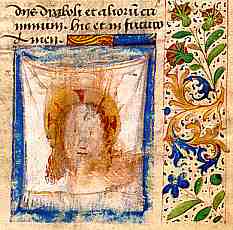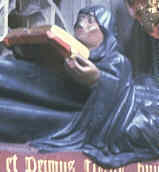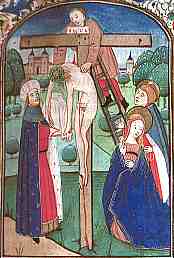 |
|
Miniatures |
|
The
pictures, either full page or smaller, found in manuscript
books are referred to as miniatures.
This is not because they are particularly small. The term derives from
the Latin minium, meaning red lead, with
which the pictures were initially drawn. However, compared to painting
in other media, they are small, so the term has acquired a resonance which
diverges from its strict etymology. Manuscript miniatures are the most
prolifically surviving examples of medieval art and some are of the most
elegant quality. The study of miniatures is a branch of art history in
its own right. They have been extensively illustrated and written about.
Schools of painting and individual artists have been identified. |
|
In
the earlier part of the medieval period, the scribe
of a manuscript was also sometimes the illustrator, as evidenced by inscriptions
and colophons. |
|
Later,
when the production of books became more commercialised, the miniaturist became
a specialised job. This was the final stage of completion of a book, with
the painter working under instruction to place the miniatures in the spaces
assigned, with the content decided by the bookseller and client in consultation.
Even the finest artist worked under orders. No wild creative flights of fantasy
here. The genius had to be in the detail. There are numerous manuscripts extant
with unfinished miniatures, where the process was never finally completed. |
|
Not
all manuscript miniatures were the brightly coloured and gilded productions
so beloved of beautiful modern picture books. In some cases outline drawings
actually represented the finished product. |
|
|
The
intricately drawn miniatures of the 11th century Harley Psalter (British
Library, Harley 603), a copy of a 9th century Carolingian work, were executed
as coloured line drawings. By permission of the British Library. |
 |
As
with historiated
initials, the content of miniatures related to the text. They thus
served as placemarkers in the text and identified the beginnings of particularly
significant passages. In the case of liturgical works, they could serve as a mnemonic for the remembering of such passages
and they also created a spiritual space and environment. They do not just
illustrate the book, they are part of the spiritual power of the book
which itself is a sacred object as well as a medium for recording sequences
of words. |
|
Above,
as is usual, a 15th century book of hours displays a miniature of a funerary
mass at the beginning of the section containing the vigils of the dead (National
Library of Australia, MS 1097/9, f.86r), by permission of the National Library
of Australia.
At
right, the small kneeling figure of a canon reads the office for the dead
from an enormous book at the feet of the funerary effigy of the founder of
the Augustinian house of St Barthlomew, Smithfield London. |
|
|
This
concept of the miniature as an aid to spirituality and devotion rather
than as a text illustration is evidenced in the standard scheme of decoration
of the book of
hours. Each office in the section containing the hours of the Virgin
generally begins with a miniature which does not directly illustrate the
text. In the most common scheme it illustrates episodes from the life
of the Virgin and the nativity. An alternative scheme uses scenes from
the passion of Christ. These do not relate literally to the words on the
page, but are aids to contemplation of holy concepts associated with the
Virgin Mary. |
|
|
In
a 15th century book of hours (National Library of Australia, MS 1097/9,
f.48r) the section on vespers of the hours of the Virgin begins with a
miniature of the deposition from the cross, with the Virigin kneeling
at the foot. By permission of the National Library of Australia. |
 |
Sometimes there was more than just mental contemplation involved. The book of hours tided the devout reader through life's troubles, and the images in it were regarded as efficacious as direct conduits to Christ, the Virgin Mary or the saints. Images were clutched or kissed in times of strife. The little miniature on the left of Christ's face on Veronica's handkerchief is seriously smudged and I suspect we are looking at the results of somebody's ancient travails. Veronica's handkerchief, according to Christian legend but not Biblical authority, was used to wipe the suffering face of Christ during the Passion, and is therefore highly symbolic for the relief of suffering. |
| Miniature of St Veronica's handkerchief on a page from a 15th century French book of hours, from a private collection. |
|
|
|
|
continued |
 Decoration Decoration |
|
 |
 |
 |




